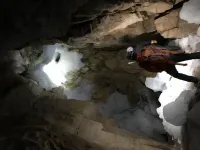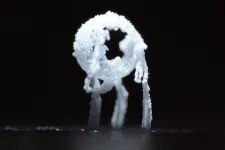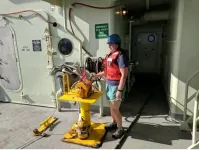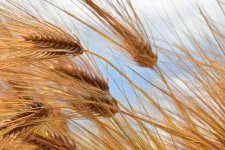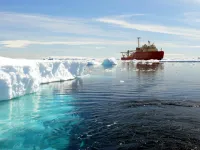(Press-News.org) Chestnut Hill, Mass. (4/28/2021) -- The vast frozen terrain of Arctic permafrost thawed several times in North America within the past 1 million years when the world's climate was not much warmer than today, researchers from the United States and Canada report in today's edition of Science Advances.
Arctic permafrost contains twice as much carbon as the atmosphere. But the researchers found that the thawings -- which expel stores of carbon dioxide sequestered deep in frozen vegetation -- were not accompanied by increased levels of CO2 in the atmosphere. The surprising finding runs counter to predictions that as the planet warms, the volume of these natural carbon stores can add significantly to CO2 produced by human activity, a combination that could increase the climatological toll of greenhouse gases.
The team of researchers explored caves in Canada to look for clues left in speleothems -- mineral deposits accumulated over thousands of years -- that might help answer when in the past did Canadian permafrost thaw and how much warmer was the climate, said Boston College Associate Professor of Earth and Environmental Sciences Jeremy Shakun, a co-author of the study.
The team was following up on a 2020 study that dated samples from caves in Siberia. That research found records of permafrost thawing until about 400,000 years ago, but little since then. Since the study focused on only a single region, the researchers sought to expand the search for a more representative view of the Arctic region, said Shakun, a paleoclimatologist.
During the course of two years, the researchers dated 73 cave deposits from several now-frozen caves in Canada. The deposits offer tell-tale clues to climatological history because they only form when the ground is thawed and water is dripping in a cave. By dating the age of the speleothems, the scientists were able to determine when in the past the regions had thawed.
Shakun said the results are very similar to the earlier Siberian study, suggesting that Arctic permafrost became more stable over the ice age cycles of the past couple million years.
But he said the team was surprised to find that many of the speleothems from the high Arctic turned out to be much younger than expected. Their relatively young ages mean permafrost thawing formed mineral deposits when the world was not much warmer than it is today.
Sediment cores from the Arctic Ocean hint at what might have been going on then.
"The summers were ice free before 400,000 years ago," Shakun said. "That would have heated the land up more during the summer and insulated it under deeper snows in the winter, causing the ground to thaw."
That theory is cause for concern if correct, he added. "Half of the Arctic sea ice has disappeared since I was born, so this may be making the permafrost more vulnerable again."
Second, records of the ancient atmosphere show that greenhouse gas levels were not any higher during the past intervals of permafrost thaw we identified -- this is surprising because the standard view is that massive amounts of carbon should be released to the atmosphere when the permafrost thaws.
Shakun said the findings call for further research to understand what allowed the permafrost to thaw at times in the past when it was not much warmer, and why there is little evidence for a big carbon release at those times.
"These findings do not fit easily with typical global warming predictions for the future," said Shakun. "They may mean that scientists have overlooked processes that will prevent permafrost thaw from causing a big spike in CO2 going forward. On the other hand, it might just be that the gradual thawing events in the past were slow enough that the CO2 they released could be absorbed by the oceans or plants elsewhere - a situation that may not apply to the much faster warming today."
INFORMATION:
In addition to Shakun, co-authors of the report included David McGee, Ben Hardt and Irit Tal, of MIT, Alberto Reys, of the University of Alberta, Derek Ford, of McMaster University, Bernard Lauriol, of the University of Ottawa, former BC graduate student Nicole Biller-Celander and geologist Corinne Wong, formerly of BC.
About a quarter of a percent of the entire gross domestic product of industrialized countries is estimated to be lost through a single technical issue: the fouling of heat exchanger surfaces by salts and other dissolved minerals. This fouling lowers the efficiency of multiple industrial processes and often requires expensive countermeasures such as water pretreatment. Now, findings from MIT could lead to a new way of reducing such fouling, and potentially even enable turning that deleterious process into a productive one that can yield saleable products.
The findings are the result of years of work by recent MIT graduates Samantha McBride PhD '20 and Henri-Louis Girard PhD '20 with professor of mechanical ...
Two teams have created a new generation of highly specific CAR T cells, which safely cleared solid tumors in mice with mesothelioma, ovarian cancer, and the deadly brain cancer glioblastoma while outlasting and outperforming conventional CAR T cell designs. The results suggest these cells could minimize the risk of dangerous side effects and address the traditionally poor performance of CAR T cells against solid tumors in the clinic. CAR T cells are genetically modified human T cells and have shown impressive performance in patients with leukemia. However, CAR T cells don't work as well against solid tumors, as these cancers lack molecular targets that the cells can easily recognize. ...
The number of distinctive sources and voices on the internet is proven to be in long-term decline, according to new research.
A paper entitled 'Evolution of diversity and dominance of companies in online activity' published in the PLOS ONE scientific journal has shown between 60 and 70 percent of all attention on key social media platforms in different market segments is focused towards just 10 popular domains.
In stark contrast, new competitors are struggling to survive against such dominant players, with just 3 percent of online domains born in 2015 still active today, compared to nearly 40 percent of those formed back in 2006.
The researchers say ...
The subseafloor constitutes one of the largest and most understudied ecosystems on Earth. While it is known that life survives deep down in the fluids, rocks, and sediments that make up the seafloor, scientists know very little about the conditions and energy needed to sustain that life.
An interdisciplinary research team, led from ASU and the Woods Hole Oceanographic Institution (WHOI), sought to learn more about this ecosystem and the microbes that exist in the subseafloor. The results of their findings were recently published in Science Advances, with ASU School of Earth and Space Exploration assistant professor and geobiologist ...
Organ development in plants mostly occurs through combinatorial activity of so-called meristems. Meristems are plant cells or tissues that give rise to new organs, similar to stem cells in human - including spikelets. Spikelets are components of the spike and form florets (flowers) themselves, which in turn produce grains after fertilisation.
Inflorescence morphogenesis in grasses (Poaceae) is complex and based on a specialised floral meristem, the spikelet meristem, from which all other floral organs arise and which also gives rise to the grain. The fate of the spikelet thus determines not only reproductive success, ...
DETROIT (April 28, 2021) - The results of a large, national heart attack study show that patients with a deadly complication known as cardiogenic shock survived at a significantly higher rate when treated with a protocol developed by cardiologists at Henry Ford Hospital in END ...
Anyone researching the global carbon cycle has to deal with unimaginably large numbers. The Southern Ocean - the world's largest ocean sink region for human-made CO2 - is projected to absorb a total of about 244 billion tons of human-made carbon from the atmosphere over the period from 1850 to 2100 under a high CO2 emissions scenario. But the uptake could possibly be only 204 or up to 309 billion tons. That's how much the projections of the current generation of climate models vary. The reason for this large uncertainty is the complex circulation of the Southern Ocean, which ...
A protein variant common in malignant bladder tumor cells may serve as a new avenue for treating bladder cancer. A multi-institution study led by END ...
Veterinarians, pet owners and breeders often have preconceived notions about each other, but by investigating these biases, experts at the University of Arizona College of Veterinary Medicine hope to improve both human communication and animal care.
"Veterinary medicine may require us to treat the patient, but we are unable to improve pet patient outcomes without human client consent and trust. Communication is an essential component of veterinary practice," said Ryane Englar, an associate professor and the director of veterinary skills development for the college. "As an anecdotal example, vets and breeders don't always get along, but there was no research on these subjects. I wondered, what do the groups want and need? If ...
Washington, D.C. - April 28, 2021 - As of April 2021, more than 3 million people worldwide have died of COVID-19. Early in the pandemic, researchers developed accurate diagnostic tests and identified health conditions that correlated with worse outcomes. However, a clinical predictor of who faces the highest risk of being hospitalized, put on a ventilator or dying from the disease has remained largely out of reach.
This week in mSphere, an open-access journal of the American Society for Microbiology, researchers describe a two-step prognostic test that can help predict a patient's response to infection with SARS-CoV-2. The test combines a disease risk factor score with a test ...
